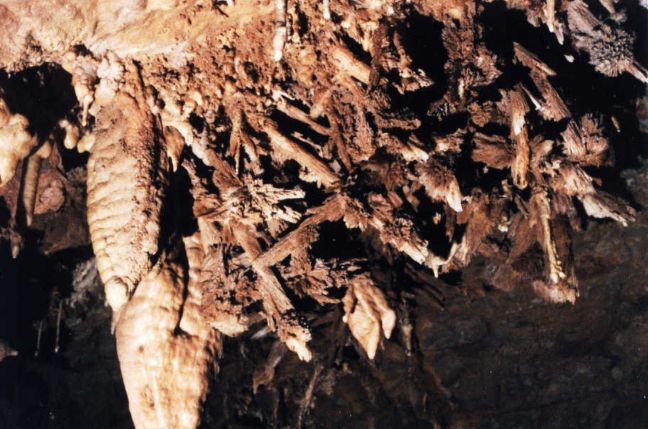|

|
Text imported from the magazine Speomond, No. 4, 1999, page 13
Although it is less known by the richness of formations in comparison with its celebrated neighbors, V11 cave and the Cave of Valea Rea, the V5 pothole won't cause any disappointment even in this aspect. While advancing through the underground cavity the visitor will be surprised - after tens and hundreds of meters of tight passages offering only bare rocks - of the true crystalline explosions appearing in the least expected locations.
Such a situation is offered also by the 1988 terminus, which got its name - not by chance - The Aragonite Chamber. Penetrating into this sector we'll practically be shocked by the view of those crystals covering the chamber's ceiling on a length of over 15 meters.
At a closer look we'll realize that we are admiring the "nobler" variety of calcium carbonate: the aragonite. A cavalcade of needle-like crystals of widths seldom more than 2 mm, grown together in parallel or in radial bunches which start from a common "root", glue to the wall or to a group of neighboring crystals. The individual lengths are also remarkable, often 20 cm, without any noticeable increase in diametre along this length.
Although these crystals in reality are translucent, even transparent, unfortunately a very fine film of clay envelops the whole edifice. This, on the other hand, is not bothering, especially because from place to place have deposited classic calcitic formations, too, of an immaculate white which forms a powerful contrast with the rusty shade of the aragonites.
It is interesting to point out the general aspect of these aragonites, different from the ones usually met in speleological environment. They are much more similar to those called "Mine Flowers" deposited in supersaturated solutions inside various geodes (which offer conditions of thermodynamic stability very seldom met in a cave), than the "usual" crystals. And, indeed, if we allocate a little more effort to our trip, somewhat further into the cave, in the upstream section of Sala Balustradei (= Banister Chamber), on the ceiling of a active passage excavated in a vadous regime, we'll find aragonites again, but this time in a form of a "butterfly wing" and efflorescent "nests", as characteristic to a cave as possible.
Reminding ourselves of the aspects linking to the (poly-phased) genesis of this pothole (DAMM 1996; SILVESTRU 1988), one will not hesitate to put the formation
of these aragonites, temporarily, on the account of the first phase, the freatic, which shaped the present day Big Chambers' Complex. Within this can be discussed only one phase slightly tardy, or possibly incipient. Only these can theoretically create the conditions of stability mentioned above, probably by blocking a bag of water inside an isolated passage segment to begin with.
Although due to post-formation, the crystals were covered with a very fine film of clay, and as time went by the more daring formations were demolished, the
aragonites of V5 represent - by type, dimensions and aesthetics - a real masterpiece of nature, that deserve all efforts of being protected!

|
|